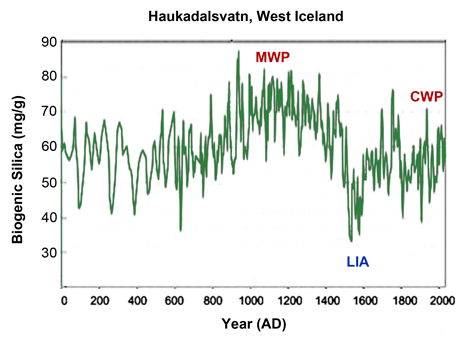Lake Haukadalsvatn, West Iceland
Reference
Geirsdottir, A., Miller, G.H., Thordarson, T. and Olafsdottir, K.B. 2009. A 2000-year record of climate variations reconstructed from Haukadalsvatn, West Iceland. Journal of Paleolimnology 41: 95-115.
Reference
Geirsdottir, A., Miller, G.H., Thordarson, T. and Olafsdottir, K.B. 2009. A 2000-year record of climate variations reconstructed from Haukadalsvatn, West Iceland. Journal of Paleolimnology 41: 95-115.
Description
Working with biogenic silica (BSi) and total organic carbon (TOC) data obtained from two sediment cores retrieved from Haukadalsvatn (65°03.064'N, 21°37.830'W) -- a lake in northwest Iceland -- and a 170-year instrumental temperature history that was obtained from Stykkisholmur (50 km distant), the authors identified "a broad peak in BSI and lack of a trend in TOC between ca. 900 and 1200 AD," which they described as being indicative of "a broad interval of warmth" that was "coincident with the Medieval Warm Period," and which clearly exhibited much greater warmth than was observed at any time during the Current Warm Period.





